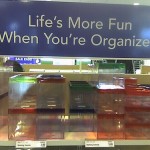“There is nothing more important than clean and orderly – in office or in life. No doubt about it – nothing. Your speed and quality of output, your mental attitude, the opinion of others, all the principles of production and management, all await and depend on order” [Aslett, 2005, p. 34].
You have probably heard the saying “A cluttered desk is the sign of a cluttered mind.” More importantly, what people perceive when they first see your space sends multiple signals about a host of intangibles: your work ethic, your conscientiousness, your ability to plan, and your overall perceived value as a colleague. Because individuals make snap judgments based on superficial aspects of our lives, our workspace is really a shop front advertising our potential (and quality) of output.
In fact, the motto of Order (an organizing company), is “Your space says everything about you” (Carlomagno, 2008). Although the skills and apprenticeship that many professionals in their training receive are intensive, nowhere in their course of study are they taught how to effectively organize their workspace, or how to streamline their office throughput. After landing that first job, the tendency is to eschew establishing an organizational system and to start peddling as fast as you can.
The result of unchecked disorder overtime can be disastrous. An office may look organized on the outside, but if there is no systematic way of dealing with paperwork or projects, and no overarching framework from which to proceed, the end result will be a jumbled chaotic treasure hunt within drawers, credenzas, and file cabinets. Having fewer things (and less places to look for them), speeds “find time,” and facilitates the maximum usage of your possessions. It goes without saying that information is of no value is it’s unreachable.
The concept of “shedding” or disposing of peripheral accumulation that is no longer necessary, can liberate you (both materially and psychologically) to embrace new ideas and projects. Accumulation can literally overwhelm your workspace, transforming your office into a debilitating collection of clutter. While guidelines do exist for the maintenance of certain types of information (such as empirical data, court documents, and legal records), much of what is inside our drawers and piled high upon our desks is unnecessary.
This blog will explore practical ways to use fewer items more efficiently through the examination of the latest software and related gadgetry. We will also examine ways to eliminate the unwanted through a redirection of our thought process, and a paradigmatic shift in what we consider important.
I look forward to taking this journey with you.
Jacqueline
__________________________________________________________
References
Aslett, D. (2005). The office clutter cure: Get organized, get results. Avon, MA: Adams Media.





Recent Comments